英语语法现在进行时归纳总结
- 格式:doc
- 大小:65.50 KB
- 文档页数:8
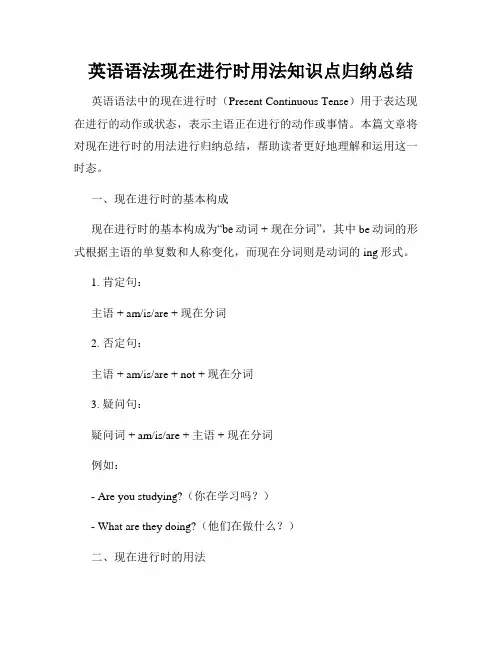
英语语法现在进行时用法知识点归纳总结英语语法中的现在进行时(Present Continuous Tense)用于表达现在进行的动作或状态,表示主语正在进行的动作或事情。
本篇文章将对现在进行时的用法进行归纳总结,帮助读者更好地理解和运用这一时态。
一、现在进行时的基本构成现在进行时的基本构成为“be动词 + 现在分词”,其中be动词的形式根据主语的单复数和人称变化,而现在分词则是动词的ing形式。
1. 肯定句:主语 + am/is/are + 现在分词2. 否定句:主语 + am/is/are + not + 现在分词3. 疑问句:疑问词 + am/is/are + 主语 + 现在分词例如:- Are you studying?(你在学习吗?)- What are they doing?(他们在做什么?)二、现在进行时的用法1. 表示现阶段正在进行或发生的动作或情况:- I am reading a book.(我正在读书。
)- They are watching TV.(他们正在看电视。
)2. 表示现阶段的变化、趋势或动态:- The population of the city is increasing rapidly.(该城市的人口正在迅速增长。
)- The weather is getting warmer.(天气正在变暖。
)3. 表示计划或安排即将发生的动作:- We are going to the cinema tonight.(今晚我们要去电影院。
)- She is leaving for Paris tomorrow.(她明天将前往巴黎。
)4. 表示现阶段的临时状况或固定安排:- I'm staying with my friend until my house is ready.(我的房子准备好之前,我暂时和我的朋友住在一起。
)- They are working on a new project this month.(他们这个月正在进行一个新的项目。
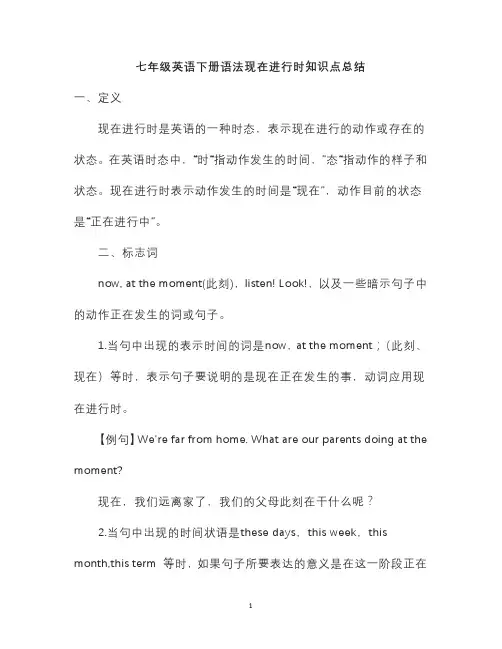
七年级英语下册语法现在进行时知识点总结一、定义现在进行时是英语的一种时态,表示现在进行的动作或存在的状态。
在英语时态中,“时“指动作发生的时间,”态“指动作的样子和状态。
现在进行时表示动作发生的时间是“现在”,动作目前的状态是“正在进行中”。
二、标志词now, at the moment(此刻),listen! Look!,以及一些暗示句子中的动作正在发生的词或句子。
1.当句中出现的表示时间的词是now,at the moment;(此刻、现在)等时,表示句子要说明的是现在正在发生的事,动词应用现在进行时。
【例句】We're far from home. What are our parents doing at the moment?现在,我们远离家了,我们的父母此刻在干什么呢?2.当句中出现的时间状语是these days,this week,this month,this term 等时,如果句子所要表达的意义是在这一阶段正在发生的事,则动词应用现在进行时。
【例句】They're having a test this week.这一周,他们在进行一次考试。
3.在句中出现了Look,Listen,Can't you see? 等暗示词时,说明后面谓语动词的动作正在发生,该动词应用现在进行时。
【例句】Look! Maria and Tom are dancing under the tree.看!玛丽亚和汤姆正在树下跳舞。
这几种动词不用现在进行时1.表示心理情感的动词:want;mind;wish;recognize;think;know;understand;hate;depend on2.表示存在位置的动词:remain;stand3.表示知觉的动词:see;hear;notice;smell4.表示所属的动词:have;possess;own;consist of5.暂时性的动词:accept;allow;decide;promise三、构成肯定句:主语+ am/is/are + 现在分词...【例句】They’re having a meeting now.他们现在正在开会。
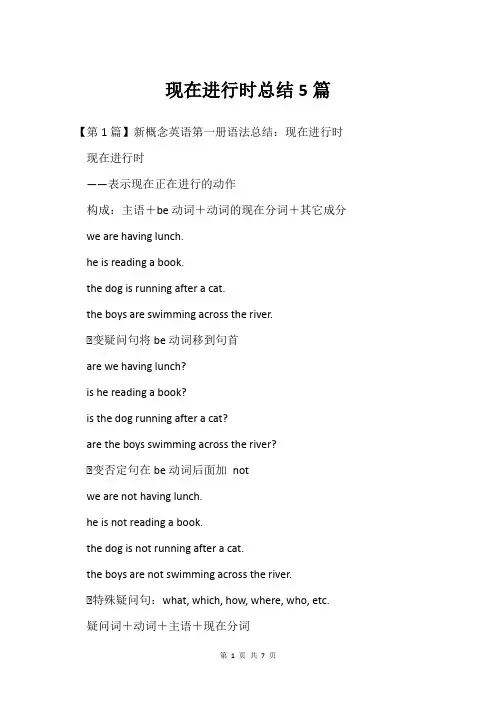
现在进行时总结5篇【第1篇】新概念英语第一册语法总结:现在进行时现在进行时——表示现在正在进行的动作构成:主语+be动词+动词的现在分词+其它成分we are having lunch.he is reading a book.the dog is running after a cat.the boys are swimming across the river.★变疑问句将be动词移到句首are we having lunch?is he reading a book?is the dog running after a cat?are the boys swimming across the river?★变否定句在be动词后面加notwe are not having lunch.he is not reading a book.the dog is not running after a cat.the boys are not swimming across the river.★特殊疑问句:what, which, how, where, who, etc. 疑问词+动词+主语+现在分词what are you doing?what is she doing?what is the dog doing?没有进行时的动词(必背)表示状态,思想,感情和感觉的动词不能表示正在进行的动作:1. 表示感觉,感官的词see, hear, like, love, want2. have, has当“拥有”讲时没有进行时【第2篇】小学英语语法总结大全:现在进行时动词加ing的变化规则1.一般情况下,直接加ing,如:cook-cooking2.以不发音的e结尾,去e加ing,如:make-making, taste-tasting 3.如果末尾是辅音字母加一个元音字母和一个辅音字母,双写末尾的辅音字母,再加ing,如:run-running, stop-stopping现在进行时,用来表示正在进行或发生的动作。
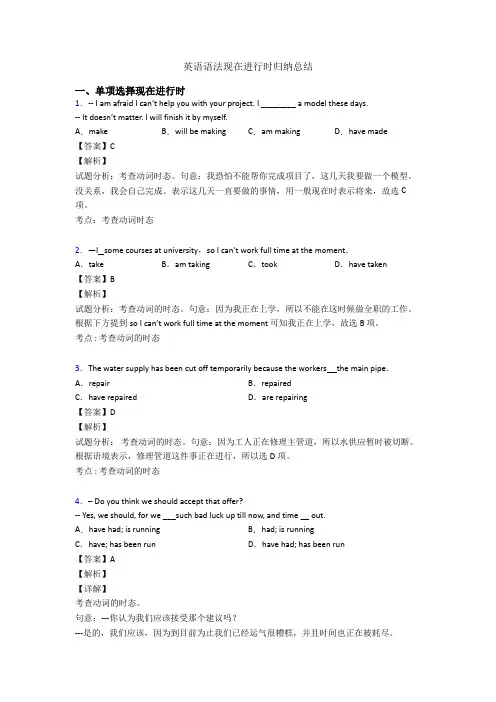
英语语法现在进行时归纳总结一、单项选择现在进行时1.-- I am afraid I can’t help you with your project. I ________ a model these days.-- It doesn’t matter. I will finish it by myself.A.make B.will be making C.am making D.have made【答案】C【解析】试题分析:考查动词时态。
句意:我恐怕不能帮你完成项目了,这几天我要做一个模型。
没关系,我会自己完成。
表示这几天一直要做的事情,用一般现在时表示将来,故选C 项。
考点:考查动词时态2.—I some courses at university,so I can’t work full time at the moment.A.take B.am taking C.took D.have taken【答案】B【解析】试题分析:考查动词的时态。
句意:因为我正在上学,所以不能在这时候做全职的工作。
根据下方提到so I can’t work full time at th e moment 可知我正在上学,故选B 项。
考点 : 考查动词的时态3.The water supply has been cut off temporarily because the workers the main pipe.A.repair B.repairedC.have repaired D.are repairing【答案】D【解析】试题分析:考查动词的时态。
句意:因为工人正在修理主管道,所以水供应暂时被切断。
根据语境表示,修理管道这件事正在进行,所以选D项。
考点 : 考查动词的时态4.– Do you think we should accept that offer?-- Yes, we should, for we ___such bad luck up till now, and time __ out.A.have had; is running B.had; is runningC.have; has been run D.have had; has been run【答案】A【解析】【详解】考查动词的时态。
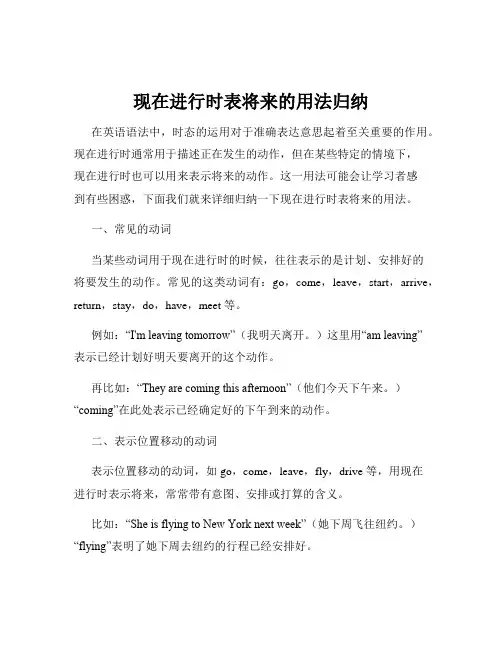
现在进行时表将来的用法归纳在英语语法中,时态的运用对于准确表达意思起着至关重要的作用。
现在进行时通常用于描述正在发生的动作,但在某些特定的情境下,现在进行时也可以用来表示将来的动作。
这一用法可能会让学习者感到有些困惑,下面我们就来详细归纳一下现在进行时表将来的用法。
一、常见的动词当某些动词用于现在进行时的时候,往往表示的是计划、安排好的将要发生的动作。
常见的这类动词有:go,come,leave,start,arrive,return,stay,do,have,meet 等。
例如:“I'm leaving tomorrow”(我明天离开。
)这里用“am leaving”表示已经计划好明天要离开的这个动作。
再比如:“They are coming this afternoon”(他们今天下午来。
)“coming”在此处表示已经确定好的下午到来的动作。
二、表示位置移动的动词表示位置移动的动词,如 go,come,leave,fly,drive 等,用现在进行时表示将来,常常带有意图、安排或打算的含义。
比如:“She is flying to New York next week”(她下周飞往纽约。
)“flying”表明了她下周去纽约的行程已经安排好。
又如:“The bus is leaving in five minutes”(公交车五分钟后出发。
)这里“leaving”清晰地传达了公交车出发的时间是已经确定好的未来时刻。
三、现在进行时表将来的时间状语当现在进行时用于表示将来时,常常会有一些特定的时间状语来加以说明,以便更明确地表达动作发生的时间在未来。
常见的时间状语有:tomorrow,next week,soon,in a few days,in the future 等。
例如:“I'm meeting him tomorrow”(我明天要见他。
)“tomorrow”清晰地指出了见面这个动作发生在明天。
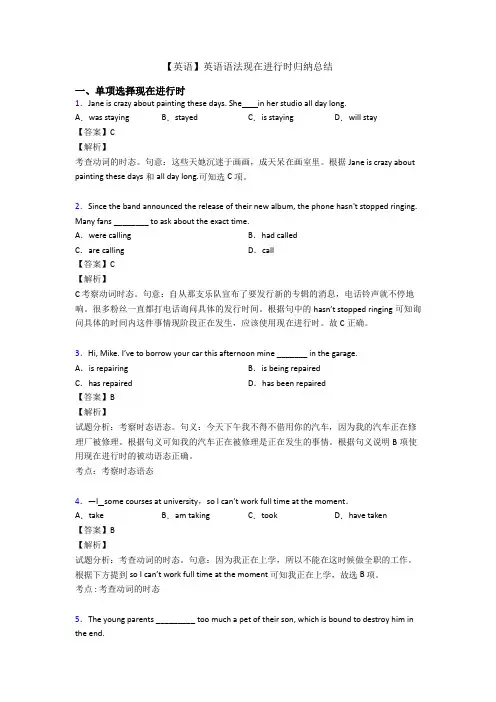
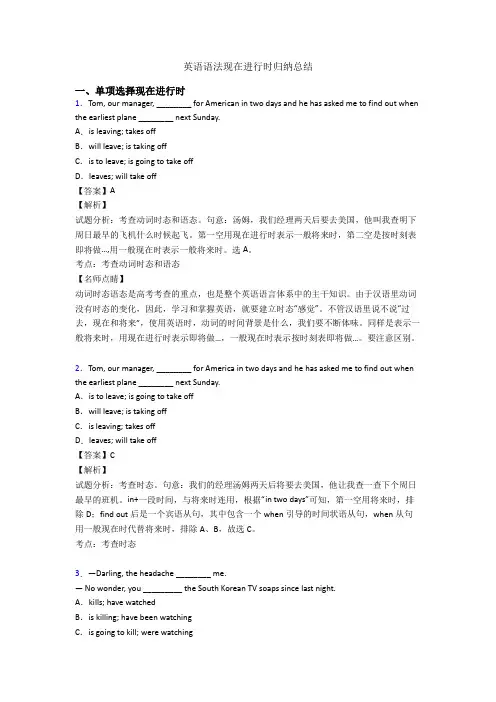
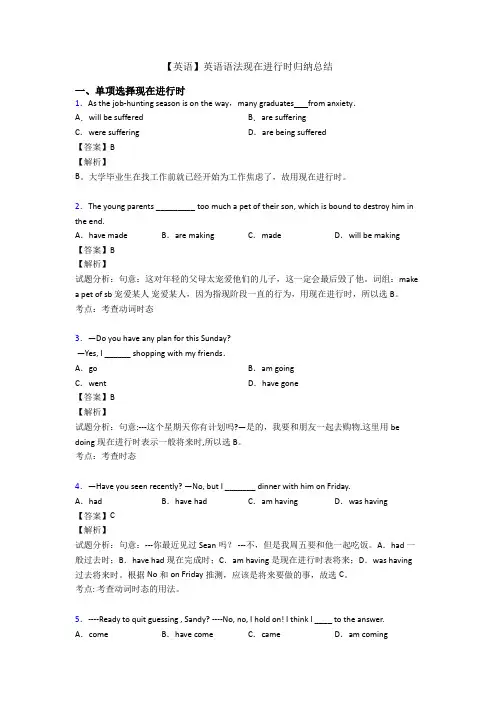
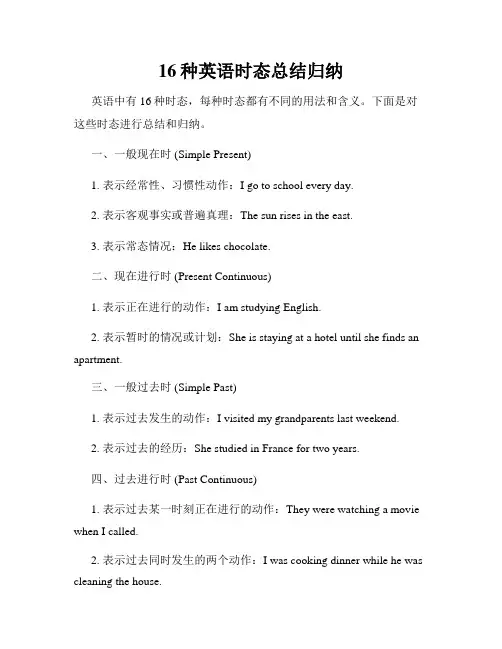
16种英语时态总结归纳英语中有16种时态,每种时态都有不同的用法和含义。
下面是对这些时态进行总结和归纳。
一、一般现在时 (Simple Present)1. 表示经常性、习惯性动作:I go to school every day.2. 表示客观事实或普遍真理:The sun rises in the east.3. 表示常态情况:He likes chocolate.二、现在进行时 (Present Continuous)1. 表示正在进行的动作:I am studying English.2. 表示暂时的情况或计划:She is staying at a hotel until she finds an apartment.三、一般过去时 (Simple Past)1. 表示过去发生的动作:I visited my grandparents last weekend.2. 表示过去的经历:She studied in France for two years.四、过去进行时 (Past Continuous)1. 表示过去某一时刻正在进行的动作:They were watching a movie when I called.2. 表示过去同时发生的两个动作:I was cooking dinner while he was cleaning the house.五、一般将来时 (Simple Future)1. 表示将要发生的动作:I will meet you at the park tomorrow.2. 表示决定或打算:We are going to have a party next weekend.六、将来进行时 (Future Continuous)1. 表示将来某一时刻正在进行的动作:They will be traveling to Europe this time next year.2. 表示持续性的动作:I will be working late tonight.七、现在完成时 (Present Perfect)1. 表示过去发生但与现在有关的动作:I have finished my homework.2. 表示经历或经验:He has traveled to many countries.八、过去完成时 (Past Perfect)1. 表示在过去某一时刻之前已经完成的动作:They had already left when I arrived.2. 表示顺序:She had read the book before watching the movie.九、将来完成时 (Future Perfect)1. 表示将来某一时刻之前完成的动作:I will have finished my project by tomorrow.2. 表示结果:They will have arrived by the time we get there.十、现在完成进行时 (Present Perfect Continuous)1. 表示从过去某一时刻开始一直持续到现在的动作:I have been studying for three hours.2. 表示强调动作的持续性:He has been working all day.十一、过去完成进行时 (Past Perfect Continuous)1. 表示过去某一时刻之前一直持续到过去的动作:She had been waiting for two hours when the bus finally arrived.2. 表示强调动作的持续性:They had been playing tennis all afternoon.十二、将来完成进行时 (Future Perfect Continuous)1. 表示将来某一时刻之前持续进行的动作:I will have been studying for five hours by the time the exam starts.2. 表示强调动作的持续性:They will have been working on the project for a month.十三、虚拟现在时 (Present Unreal)1. 表示与现在事实相反的假设:If I were rich, I would buy a mansion.2. 表示建议或要求:I suggest that he study more.十四、虚拟过去时 (Past Unreal)1. 表示与过去事实相反的假设:If I had studied harder, I would have passed the exam.2. 表示遗憾或后悔:I wish I had bought that dress.十五、虚拟将来时 (Future Unreal)1. 表示与将来事实相反的假设:If I won the lottery, I would travel the world.2. 表示不可能实现的愿望:I wish she would become a famous singer.十六、过去将来时 (Future in the Past)1. 表示过去某一时刻之后将要发生的动作:He said he would call me later.2. 表示过去的计划:I thought we were going to have dinner together.以上是对16种英语时态的总结归纳。

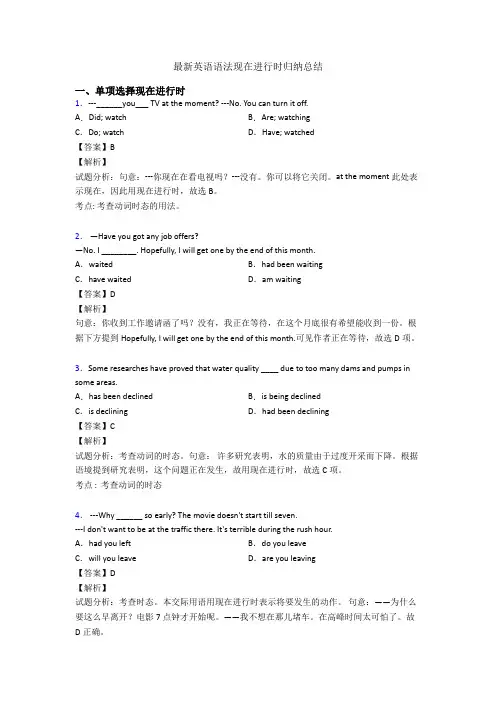
英语语法总结归纳英语语法总结归纳1、现在进行时Look, Listen是标志,现在进行正发生;有时now在句中现,“be+v-ing”时态成。
若问be用何形式,须看主语数、人称。
三单is我am,你和复数are紧随 (即:He / She is, I am. We, you,they 后are紧跟)。
v-ing形式更好记,三种构成要分清。
一般问句be提前,be后not否定成!2、一般现在时一般现在时态中,动词一般用原形。
表述事实讲真理,习惯动作常发生。
动词词尾加-s(es),只表单数三人称。
若变一般疑问句,得看句型是哪种。
系表结构和there be, be放句首即完成;若遇实义动词句,do或does莫忘记!3、一般过去时肯定句的过去式。
规则动词加ed,不规则的必须记。
否定形式疑问句,没有be加did。
如把did加在前,动词还要归原形。
4、基数词变序数词基变序,很容易,一二三,特殊记,th从四起。
八去t来九去e,遇到ve,f 替,ty变为tie,后加th莫迟疑,若想表示几十几,只变个位就可以。
5、时间介词巧记歌年、月、季节前用in,(如:in 2008, in September, in spring)日期前面行不通。
遇到几号或星期改用on来做代替, (如:on January 1,onWedesday)上午、下午、晚上仍用in。
(如:in the morning/afternoon/evening)若是某日上下午,也是用on才能行。
(如:on theevening of the Mid-autumn Day)正午、夜里用at, (如:at noon, at night)时、分用法也同理。
(如:, at two, at two)如若“差”点须加to, (如:two to two)如若“过”点改past。
(如:half past one)多说勤练牢牢记,学好英语非儿戏。
6、特殊的形容词、副词的比较级、最高级一分为二是三个, (指同一个形容词原形但是有两种比较级和最高级形式)两个“远”“来”一个“老”。
现在进行时的知识点归纳1.引言1.1 概述现在进行时是英语语法中的一个时态,用来表示正在进行的动作或状态。
它通常由谓语动词"be"的现在时形式和动词的现在分词构成。
现在进行时又被称为现在进行式。
现在进行时常用于描述此刻正在发生的事情,以及稍后可能会发生的事情。
它可以用来表达说话时的动作、习惯、临时决定等。
在现在进行时中,谓语动词的不同形式取决于主语的人称和数。
例如,当主语是第一人称单数时,谓语动词用"is";当主语是第三人称单数时,谓语动词用"is";当主语是第一或第三人称复数时,谓语动词用"are"。
此外,现在进行时还可以与一些时间状语连用,如"now"、"at the moment"、"currently"等,以强调动作正在进行。
总之,现在进行时与现在的状态和动作密切相关,它能够帮助我们更准确地描述当下正在进行的事情。
在接下来的文章中,我们将详细探讨现在进行时的构成、应用以及需要注意的事项。
1.2 文章结构文章结构是指文章整体的组织框架,它决定了文章的逻辑关系和层次结构。
一个清晰有序的文章结构可以使读者更好地理解文章的内容,并能更好地表达作者的观点和意图。
在本文中,文章结构分为引言、正文和结论三个部分。
1. 引言部分(Introduction)在引言部分,我们需要对现在进行时进行一个概述,简要介绍现在进行时的定义、构成和应用。
同时,我们还需要明确文章的结构和目的,为读者提供一个整体的导引,帮助读者理解和阅读后续的内容。
2. 正文部分(Main Body)正文部分是文章的核心部分,主要讨论和阐述现在进行时的相关知识点。
具体而言,我们可以从以下几个方面展开:2.1 现在进行时的定义在这一部分,我们可以介绍现在进行时的基本概念和定义。
现在进行时主要用于表示当前正在进行的动作或状态,通过be动词(am/is/are)加动词的现在分词形式来构成。
初中英语语法——现在进行时知识点总结归纳现在进行时是表示现在进行中的动作或状态的一种时态。
它由be动词(am/is/are)+动词的ing形式构成。
下面是现在进行时的一些重要知识点总结和归纳。
1. 现在进行时的基本结构:主语 + am/is/are + 动词-ing + 其他成分。
例如:- I am reading a book.(我正在读一本书。
)- She is playing volleyball.(她正在打排球。
)- They are studying for the exam.(他们正在为考试学习。
)2.现在进行时的用法:-表示现在正在进行的动作或状态。
例如:- He is watching TV.(他正在看电视。
)- They are playing football.(他们正在踢足球。
)-表示现阶段的临时动作。
例如:- She is learning to play the piano.(她正在学弹钢琴。
)- We are staying at the hotel for the night.(我们正在旅馆过夜。
)-表示计划或安排的未来动作。
例如:- I am meeting my friends for lunch tomorrow.(明天我要和朋友们共进午餐。
)- They are going to the beach this weekend.(他们这个周末要去海滩。
)3.否定句和疑问句的构成:- 否定句:主语 + am/is/are + not + 动词-ing + 其他成分。
例如:- He is not working now.(他现在不工作。
)- We are not playing soccer.(我们不在踢足球。
)- 疑问句:Am/Is/Are + 主语 + 动词-ing + 其他成分?例如:- Are you studying for the test?(你在为考试学习吗?)- Is she watching a movie?(她在看电影吗?)4.特殊情况的处理:- 当动词以e结尾时,需将e改为ing。
高中英语语法八个时态归纳总结英语语法中的时态是指动词形态变化来表示不同的时间状态。
在英语语法中,共有八个时态,包括一般现在时、一般过去时、一般将来时、现在进行时、过去进行时、过去将来进行时、现在完成时和过去完成时。
这里将对这八个时态进行归纳总结,以帮助高中学生更好地理解和运用这些时态。
1. 一般现在时(Simple Present)一般现在时表示经常性、习惯性的动作或真理,也用于表示主语在现在的状态或职业。
例句:- I eat breakfast every morning.(我每天早上吃早餐。
)- The sun rises in the east.(太阳从东方升起。
)- She works as a teacher.(她是一名教师。
)2. 一般过去时(Simple Past)一般过去时表示过去某个时间发生或存在的动作或状态。
例句:- I studied English yesterday.(昨天我学习了英语。
)- They went to the beach last summer.(他们去年夏天去了海滩。
)- She lived in London for five years.(她在伦敦住了五年。
)3. 一般将来时(Simple Future)一般将来时表示将来某个时间要发生的动作或存在的状态。
例句:- I will go shopping tomorrow.(我明天要去购物。
)- They are going to visit their grandparents next month.(他们下个月要去看望他们的祖父母。
)- She is going to study abroad after graduation.(她毕业后打算出国留学。
)4. 现在进行时(Present Continuous)现在进行时表示现在正在进行的动作或状态。
例句:- I am reading a book right now.(我现在正在读一本书。